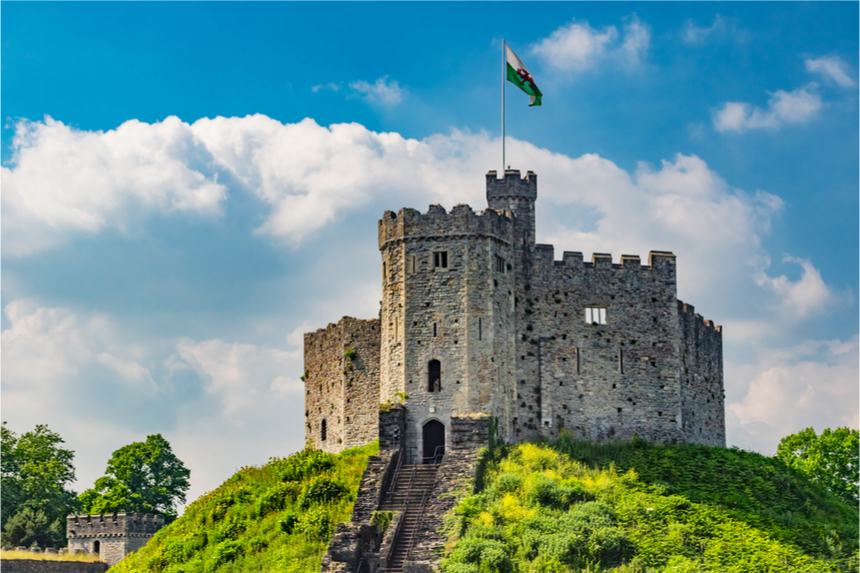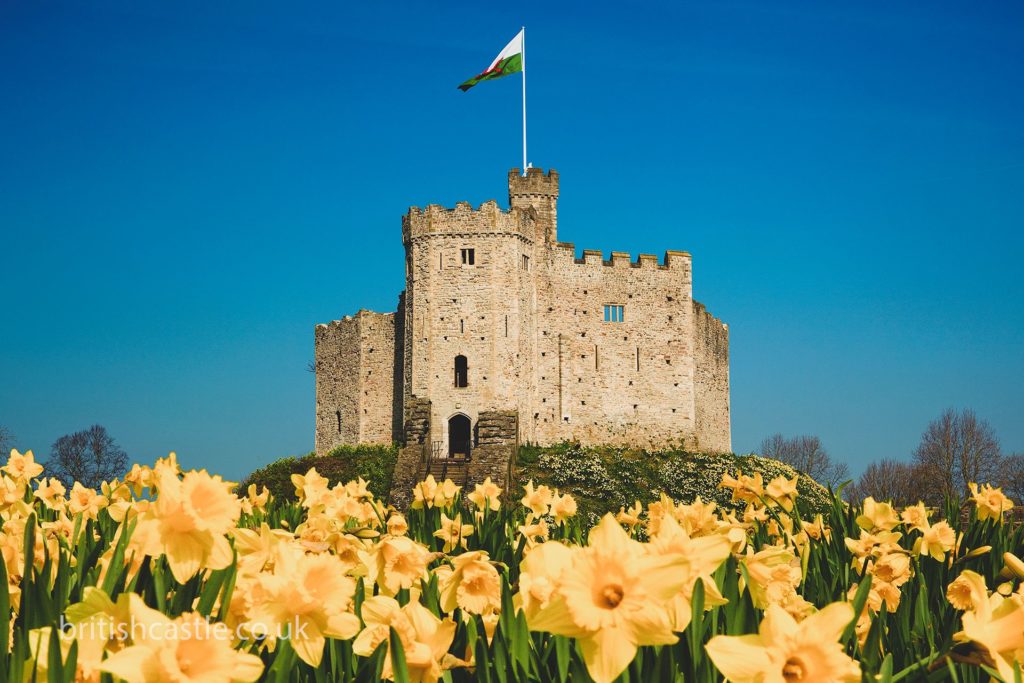Cardiff Castle is a living monument to the history of the British Isles, dating back to the Romans in the first century A.D., located in the heart of the capital city. Cardiff Castle is one of Wales’ leading heritage attractions, emphasising its international significance and rich historical narrative that spans 2,000 years.
Roman masonry that remained from the original fort can be seen at the base of the Norman walls surrounding the keep. A gatehouse or barbican leads to the motte and bailey fortification. The shell keep atop the motte remains well-preserved and is surrounded by an authentic water-filled moat.
Over the centuries, as the castle was occupied by historically prominent English families, repairs and renovations were made to the basic structures, and new buildings were added. The Black Tower was constructed during the Welsh rebellions of the 12th century. The Octagon Tower and the first hall block appeared during a time of Welsh peace in the 15th century.

However, it was the 18th century acquisition of Cardiff Castle by the Bute family that was to dramatically change the appearance of the castle. Several towers were added, including the spectacular Clock Tower, and the entire castle was renovated in a rather fanciful medieval style. Fortunately, the renovations did not totally obscure the historical features of past construction.
The Barbican Tower and a new entrance hall were built in the 20th century.
The well-preserved castle is now in the hands of the city of Cardiff. The City Council maintains Cardiff Castle and provides guided tours of its beauty and history for a fee. Further information on fees and opening times can be found on their website at http://www.cardiff.gov.uk.
Cardiff Castle History
The first known building at the site of Cardiff Castle was a Roman fort and trading post, constructed almost 2000 years ago. According to archaeological excavations, the original fortification dates from 55 AD.
It was located near the intersection of the river Taff and the Bristol Channel as a base for further Roman excursions into Britain.

As the Romans took control of Wales a smaller fort was built, in 75 AD, though by 250 AD a new fort with stone walls ten feet thick (plus an earthen bank) possibly due to rebellions. The Romans left the area in the 5th century.
Today, visitors can explore the rich history of the site, including the Firing Line: Cardiff Castle Museum of the Welsh Soldier, which showcases elements of Welsh military history.
Norman Conquest
After the Norman Conquest of 1066, William the Conqueror presented parcels of land to his generals and other nobles. Robert Fitzhamon was named Lord of Gloucester in 1081 and built a medieval castle on the western side of the original Roman fort.
At the northern end a motte or mound was constructed, surrounded by a 40 ft. moat and topped by a wooden keep. A stockade of timber protected the wooden buildings inside the bailey.
The first lord died of battle wounds in 1107, and was succeeded by his daughter, Mabel, who had married another Robert, son of Henry I. In 1122, Henry gave Robert the titles of Earl of Gloucester and Lord of Glamorgan.
To improve fortification of the castle, he replaced the wooden keep with stone. It was in this stone keep that the Earl of Gloucester imprisoned his uncle Robert, second Duke of Normandy, at the request of Henry I. The Duke remained at the castle from 1126-1134.
Welsh Rebellion
During the Welsh rebellions of 1183-1184, the castle suffered considerable damage to its curtain walls. History tells us that unrest among the Welsh would continue for several centuries. In 1216, the castle passed to the de Clare family when Gilbert de Clare became the Earl.
Gilbert was one of the barons who forced King John to sign the Magna Carta in 1215. His grandson Gilbert de Clare, still a minor when his father Richard died, attained the earldom in 1262.
The Welsh prince Llewyllyn ap Gruffydd (“the Last”) had achieved control over most of Wales by 1267. Gilbert and Llewyllyn were friends until Gilbert began to build additional castles in the area claimed by the Welshman. At this time, additional fortifications were added to Cardiff Castle to prepare for an expected attack by Llewyllyn’s army.
Gilbert repaired and strengthened the curtain wall and began construction of the Black Tower, along with a defensive wall linking it to the keep. Also, an outer ward was built on the eastern side of the wall to provide accommodations for the knights of Glamorgan and their entourage.
In 1314, Cardiff Castle went to the Despenser family through the marriage of Elizabeth de Clare (founder of Clare College, in Cambridge) to Hugh Despenser. Unfortunately, Hugh was hanged at Hereford in 1326, charged with the murder of Llewylyn Bren.
This Welsh leader, who had ignited a rebellion among his people, was imprisoned at Cardiff Castle in 1317. The castle was besieged in 1321 by neighbouring lords fighting against King Edward II, whom Hugh supported. The lords won and both Edward and Hugh were put to death in 1326.
However, the Despensers retained the castle. In the Welsh rebellion of 1400, the death of Llewylyn Bren was avenged. Both the castle and the town of Cardiff were in flames, but the castle did not suffer as much damage as the town.
When Richard Despenser died in 1414, still a ward of Henry V, his sister Isabel’s husband, Richard Beauchamp, Lord Abergavenny, succeeded. He was created Earl of Worcester 1421, but died in 1422. Isabel then married another Richard Beauchamp, Earl of Warwick, tutor of young King Henry VI.
This was a time of peace in Wales, and Richard took advantage of that fact by building the Octagon Tower and a new hall block on the west side of the castle. Richard and Isabel travelled to Normandy with the king and died there in 1437 and 1439, respectively.
War of the Roses and the Medieval Castle
In 1434, Richard Beauchamp’s daughter Ann had married Richard Neville, who supported Richard of York in the Wars of the Roses. Known as Warwick the King-maker, he played Henry VI (Lancaster) against Edward IV (York) with some success, but died in battle in 1471.
Richard Neville’s younger daughter Ann married Richard, Duke of Gloucester in 1472; he became Richard III in 1483 with Ann as his queen.
In 1485 Henry Tudor defeated Richard III. Queen Ann (Neville) had died five months before, and in 1486 the lordship of Cardiff was appointed to Jasper Tudor, Henry’s cousin. When Jasper died, the castle went to the Tudor Crown.
In 1550, King Edward VI gave Cardiff Castle to William Herbert, who had been a favourite of Henry VIII (William’s sister-in-law was Henry’s last wife, Catherine Parr). He was named Baron Herbert of Cardiff, Earl of Pembroke in 1551. William Herbert was one of Henry VIII’s executors as well as a guardian of Edward VI. Thus Cardiff Castle was again at the centre of English history.
English Civil War
When the English Civil War broke out in 1642, the Earl of Cardiff supported King Charles I against the rebellious parliament. As a result, the castle suffered a siege in 1645, but there were no serious damages. The Herberts repaired the castle and kept it up for many years, but in 1776, the last Herbert heir passed the estate to her husband John Stuart, who would become Earl of Bute.
The Bute family significantly impacted the development of the castle and the surrounding city of Cardiff. Many improvements were made by architect Henry Holland, as well as a reworking of the castle’s landscape by the well-known landscape artist “Capability” Brown. The moat around the keep was filled in for a period, but the original Norman structures were left relatively untouched.
In 1865, the 3rd Marquess of Bute, John Patrick Crichton-Stuart, employed architect William Burges to renovate Cardiff Castle in the Gothic Revival style. This was a major turning point in the castle’s history. A dazzlingly colourful Clock Tower was added, soon to become a symbol of Cardiff. The Castle Apartments, known for their lavish interiors designed by Burges, are a highlight of these renovations and are included in tours that emphasise their historical significance and opulent design.
Burges’ redecorations reflected his fantasy of medieval architecture and design; thus, his flamboyance often almost obscures the castle’s true past. Several other towers were added, including the Bute Tower, Herbert Tower, Guest Tower and Tank Tower. The old hall block was replaced with a new library and banqueting hall complex.
Under the 4th Marquess, additional restoration was carried out between 1900-1930. The castle walls, including the Roman wall, were repaired, and the Barbican Tower was constructed. In 1927, a new entrance hall was built.
World War II
Cardiff Castle emerged from the World War II Blitz relatively unscathed, although buildings close to it were destroyed. It was given to the city of Cardiff in 1947.
Cardiff City Council has preserved the historical castle up to the present, and continues to offer guided tours year round with an admission fee.
The Castle Key program allows local residents of Cardiff to gain free admission to Cardiff Castle for three years. This program encourages community engagement by providing free admission to eligible local residents and workers in Cardiff.
Architecture and Design
Cardiff Castle’s architecture is a testament to its storied history, showcasing a captivating blend of Roman, Norman, and Victorian styles. The castle’s walls and fairy-tale towers conceal 2,000 years of history, with remnants of the original Roman fort still visible in some areas. Dominating the Castle Green, the Norman keep, built in the 11th century, offers stunning views of the city and stands as a proud symbol of Cardiff’s medieval past.
The transformation of the castle into a Victorian Gothic masterpiece in the 19th century by the Bute family added a layer of opulence and fantasy. The interior of the castle is adorned with gilded decorations, elaborate wood carvings, intricate murals, and vibrant stained glass, reflecting the grandeur and artistic vision of the era. Each room tells a story, blending historical authenticity with the romanticism of the Victorian age, making Cardiff Castle one of Wales’ leading heritage attractions.
Conservation and Preservation
Cardiff Castle is not only a historical treasure but also a Scheduled monument and a Listed Building – Grade I. It is listed on the Cadw/ICOMOS Register of Parks and Gardens of Special Historic Interest in Wales, underscoring its national significance. The conservation and preservation of the castle are of utmost importance, with ongoing efforts to protect and restore its historic buildings and grounds.
Extensive restoration work has been carried out on the castle’s walls and towers, ensuring that the Roman walls retain their original integrity. The castle’s museum and interpretation centre, the Firing Line, plays a crucial role in preserving the history and heritage of the castle and its surroundings. Visitors can explore the castle’s original features, including the Norman keep and Roman walls, and delve into its history through informative tour guides and interactive exhibits. These efforts ensure that Cardiff Castle remains a world-class heritage attraction for future generations to appreciate and enjoy.